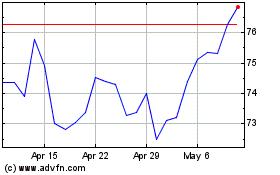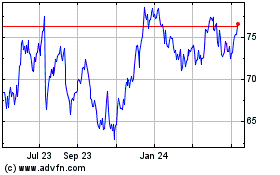By Ryan Tracy
WASHINGTON -- Regulators ordered five huge U.S. banks to make
significant revisions to their so-called living wills by Oct. 1 or
face potential regulatory sanctions, a stern warning that will fuel
criticism the firms are "too big to fail."
J.P. Morgan Chase & Co., Wells Fargo & Co., Bank of
America Corp., Bank of New York Mellon Corp., and State Street
Corp. were found by the Federal Reserve and the Federal Deposit
Insurance Corp. to have plans for a possible bankruptcy that don't
meet the legal standard laid out in the 2010 Dodd-Frank law, which
requires that firms have credible plans to go through bankruptcy at
no cost to taxpayers.
They said those firms had until October to present plans
regulators find acceptable, or the agencies or regulators could
impose higher capital requirements, restrictions on growth or
activities, or other sanctions.
Bank stocks, however, rallied in premarket trading, led by J.P.
Morgan, which reported smaller-than-expected declines in earnings
and revenue for the first quarter despite difficult trading
conditions.
The regulators split in their assessments of Goldman Sachs Group
Inc. and Morgan Stanley. The FDIC said that Goldman Sachs's plan
didn't meet the legal standard, while the Fed didn't give that
negative assessment.
The two regulators took the opposite stance on Morgan Stanley.
The Fed "identified a deficiency" in Morgan Stanley's plan that it
said didn't meet the legal standard, but the FDIC didn't go that
far, the agencies said in a news release.
Citigroup Inc. was the only firm whose plan wasn't rejected by
both agencies, though the Fed and FDIC said the firm's plan had
"shortcomings that the firm must address" by July 2017.
The living wills had been submitted by the eight U.S. banks that
had been deemed "systemically important financial institutions," or
SIFIs, that are seen as being so large that their distress could
put the economy at risk.
The agencies "are committed to carrying out the statutory
mandate that systemically important financial institutions
demonstrate a clear path to an orderly failure under bankruptcy at
no cost to taxpayers," said FDIC Chairman Martin Gruenberg in a
statement Wednesday. "Today's action is a significant step toward
achieving that goal."
Overall, the regulators were less harsh in their assessments on
the Wall Street-focused firms than on the universal and commercial
banks.
While officials say they are imposing a much-needed new caution
on a financial system that collapsed eight years ago, critics say
that the tight leash they have attached to the largest banks may be
undermining the sector's recovery, imposing new rules that
discourage lending, crimp market liquidity, and erode bank
profitability.
John Dearie, acting chief executive of the Financial Services
Form, a trade group representing all of the large banks' CEOs
except Wells Fargo, issued a statement Wednesday describing the
regulators' concerns as "technical shortcomings" that the industry
is committed to address.
"No financial company should be considered too big to fail," he
said.
J.P. Morgan has previously said its living will is credible and
that it has a "fortress balance sheet" that would prevent it from
ever needing to tap taxpayers for help in a crisis. "We will be
vigilant and will never take such a high degree of risk that it
jeopardizes the health of our company...this is a bedrock
principle," Chief Executive James Dimon said in his recent
shareholder letter.
The verdicts from the regulators don't mean that they expect any
of the banks are in imminent danger of going bankrupt. Indeed,
other provisions of the regulatory safety net adopted since the
2008 crisis are intended to make such a calamity less likely,
notably the separate exercise of annual "stress tests," where banks
need to prove they could withstand a severe economic shock. The
living wills are set up to examine whether, if banks still reach a
perilous state despite have gone through the stress tests, they can
go through bankruptcy without triggering a financial crisis, or
requiring a taxpayer bailout.
Regulators' explanations for their conclusions on the living
wills varied by firm, and the agencies released letters describing
their findings addressed to each firm's chief executive. The
letters were partially redacted, and also detailed positive
progress each firm has made toward a credible bankruptcy
strategy.
In general, the problems included what regulators called
insufficient analysis to prove the bankruptcy strategies could go
off as planned, as well as what they said was inadequate progress
toward reducing the firms' complexity and making them easier to
break apart or wind down if necessary without taxpayer help.
On a conference call with reporters Wednesday, senior officials
at the agencies said they believed the firms could address
regulators' concerns by October, though doing so could require
difficult choices that the firms might not otherwise make to run
their businesses efficiently during normal times.
They noted that the regulators have said they expect the firms
to be thinking about how they would handle their own failure "on a
continual basis" as they make daily decisions about how to
structure and fund their operations.
J.P. Morgan "has made notable progress in a range of areas," the
agencies said, but "has key vulnerabilities that could undermine
the feasibility of the plan" related to its estimated need for
cash, or liquidity, in a crisis and its vast structure of legal
entities.
Wells Fargo, which had previously received more positive
feedback than other firms, was found to have made "material
errors...that undermine confidence" in its preparedness for
bankruptcy.
Write to Ryan Tracy at ryan.tracy@wsj.com
(END) Dow Jones Newswires
April 13, 2016 08:58 ET (12:58 GMT)
Copyright (c) 2016 Dow Jones & Company, Inc.
State Street (NYSE:STT)
Historical Stock Chart
From Jun 2024 to Jul 2024

State Street (NYSE:STT)
Historical Stock Chart
From Jul 2023 to Jul 2024
